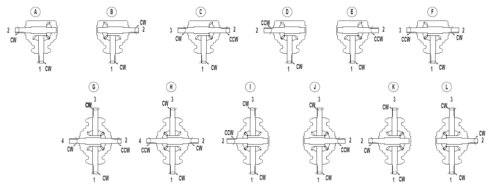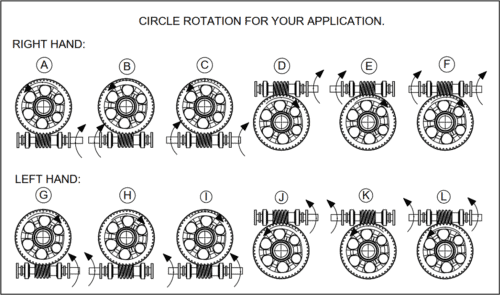Gears are vital in powering countless machines and equipment, serving as indispensable components in various applications. Available in a wide array of shapes and sizes, they are meticulously designed to fulfill specific tasks, ensuring the seamless operation of a system.
In this blog, we’ll go over the main functions of gears and their diverse rotation options. We will also discuss how these specialized mechanisms enhance a system’s performance.
Gear Functions
Gears are crucial in power transmission and motion control in many machines and equipment. They come in various shapes and sizes, each designed to perform specific tasks. Let us explore their primary functions and how they contribute to the overall performance of a system:
- Change the direction of a rotating shaft: Meshing two gears reverses their rotation, which is useful for changing rotational direction in applications like conveyor belts or rotating wheels.
- Convert rotary motion to linear motion: Rack and pinion systems convert rotary motion to linear movement using a round gear and toothed rack, often found in car steering and automation.
- Change rotational direction (clockwise/counterclockwise): Various gear arrangements determine shaft rotation direction, either reversing it with matching gears or keeping it consistent using idler gears.
- Change the number of rotations (speed up/slow down): Gears with varying teeth numbers control input-output shaft speed ratios, resulting in faster or slower output shaft rotations depending on the teeth count.
- Change turning force (increase/decrease torque): Altering gear ratios affects torque, increasing it for more force with fewer input teeth or decreasing it for faster movement with more input teeth.
Rotation Options
Gears are essential components in various machines and equipment, enabling them to perform specific functions. Understanding the different types of gear and their rotation options can help you choose the most suitable one for your application.
Bevel Gear Drives
Bevel gear drives are commonly used for right-angle power transfer because they have two or three shafts arranged at a 90-degree power shift. Counter-rotating spiral bevel gearboxes, or standard two- and three-way right-angle gearboxes, are versatile since they offer two output shafts with different rotation directions.

Right-angle bevel gear drives provide different rotation options depending on the arrangement of the bevel gears and their orientation. Here are some common rotation options for right-angle bevel gear drives:
Clockwise to Clockwise (CW to CW): In this configuration, the input shaft rotates clockwise, and the output shaft also rotates clockwise, but the direction of rotation is changed by 90 degrees. This is a common arrangement used in various applications where a change in direction is required without changing the sense of rotation.
Clockwise to Counterclockwise (CW to CCW): In this arrangement, the input shaft rotates clockwise, and the output shaft rotates counterclockwise. This is achieved by using a combination of bevel gears with opposite helix angles or other gear arrangements.
Counterclockwise to Clockwise (CCW to CW): This is the reverse of the previous option, where the input shaft rotates counterclockwise, and the output shaft rotates clockwise. It also involves using gears with specific helix angles to achieve the desired rotation change.
Counterclockwise to Counterclockwise (CCW to CCW): In this configuration, the input shaft rotates counterclockwise, and the output shaft also rotates counterclockwise, but the direction of rotation is changed by 90 degrees. It is another option for changing the direction of rotation while maintaining the sense of rotation.
Variable Rotation Ratios: Bevel gear drives can be designed to provide different rotation ratios between the input and output shafts, allowing for adjustments in rotational speed and torque. This can be achieved by selecting specific gear ratios and gear sizes.
Multiple Outputs: Some right-angle bevel gear drives can have multiple output shafts branching off at different angles from the input shaft. This provides the ability to drive multiple components or mechanisms simultaneously.
Compound Gear Arrangements: More complex arrangements, such as compound bevel gear sets, can be used to achieve specific rotation and direction changes for intricate applications.
It’s important to note that the specific rotation options available will depend on the design and configuration of the bevel gear drive, including the type of bevel gears used, their helix angles, and the overall gear arrangement. Engineers can select the most suitable rotation option based on the requirements of the application and the desired mechanical characteristics.
Low Input Speed Reducers
Designed specifically for applications requiring reduced speeds, low input speed reducers are available in two distinct configurations to cater to various needs and mechanical setups.

Right Handed
In the right-handed configuration, the output shaft rotates in the same direction as the input shaft, ensuring a consistent and synchronized motion between both components. This option is particularly suitable for situations where maintaining a uniform direction of rotation across the system is crucial.
Left Handed
The left-handed configuration features an output shaft that rotates opposite to the input shaft. This counter-rotating motion can be necessary for certain applications where reversing the direction of rotation is required or beneficial.
Industrial Worm Gear Drives
Worm gear drives are designed for high torque applications and provide a versatile range of rotation options to suit diverse requirements. These gear drives feature helical teeth contributing to their smooth and quiet operation while maintaining efficient performance.
The output shaft in worm gear drives can be set for rotation options like clockwise, counterclockwise, or even both directions, based on the application’s needs. This flexibility makes them great for many applications requiring high torque and custom rotation settings.
Unlock the Full Potential of Gears With Superior Gearbox Company
Elevate your machines and equipment to new heights of efficiency by harnessing Superior Gearbox Companys expertly designed gears! We offer various gear solutions, perfect combinations, and rotation options for optimal system performance.
Contact us today to learn more about our unparalleled capabilities or request a quote to get started on your journey to seamless gear integration.

